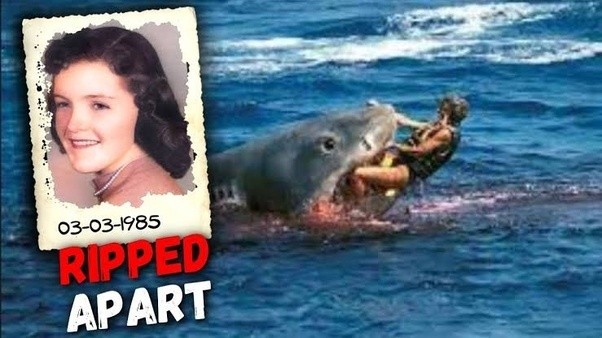On March 3, 1985, a horrifying and tragic event unfolded along the shores of Peake Bay, South Australia, forever etching a grim chapter in the annals of Australian history. It was a day that would haunt the Durdin family and shock the entire nation, as Shirley Ann Durdin, a 33-year-old mother of four, met a gruesome and unprecedented fate at the jaws of a 20-foot great white shark.
Shirley Durdin’s life took an unimaginable turn as she embarked on a seemingly ordinary activity – diving for scallops in the serene waters of Peake Bay. What should have been a leisurely day by the beach with her family quickly transformed into a nightmarish scenario that defied belief.
As Shirley ventured beneath the waves, her husband, Barry, and their children watched from the shore, approximately 150 yards away. The family had relocated from the rural town of Karkoo, a place they left behind due to Barry’s severe allergies to farm life. Their move to the coast was meant to be a fresh start, a chance to enjoy the beauty of the sea and create cherished memories together. Little did they know that fate had a much darker plan in store for them.
Eyewitness accounts of that fateful day describe a harrowing scene. A colossal great white shark, estimated to be a staggering 20 feet in length, suddenly emerged from the depths. In a matter of seconds, it tore Shirley in half, rendering her helpless and lifeless in the merciless grip of this apex predator. The tranquil waters of Peake Bay were instantly transformed into a horrifying arena of survival, where one woman faced a predator from the depths of the ocean.
Shirley’s family, paralyzed with shock and horror, could do nothing but bear witness to this gruesome attack. Barry, in his helpless state, reportedly cried out in despair, “she’s gone, she’s gone,” as the shark fed on his beloved wife’s bloodied remains.
The aftermath of the attack was a gruesome tableau. By the time rescuers arrived at the scene, Shirley’s body had been reduced to a haunting and surreal sight—a floating headless torso. The tragedy that had unfolded was unprecedented, shocking not only for its brutality but also for its rarity. At the time, this incident marked the first fatal encounter with a great white shark in the southern waters of Australia in a decade, and it would remain etched in the collective memory of the nation for years to come.
The horror didn’t end with Shirley’s initial demise. In a surreal and macabre twist, as emergency workers attempted to recover her remains, the relentless great white shark returned to the scene. With chilling determination, the shark devoured what little remained of Shirley’s body, leaving behind a chilling emptiness in its wake.
Shirley Ann Durdin’s tragic and gruesome death serves as a haunting reminder of the unpredictable and ruthless nature of the natural world. It was an event that left an indelible mark on the collective consciousness of Australia and a grieving family forever scarred by the loss of a wife and mother. The memory of that day, when a mother was torn apart in front of her children, remains one of the most infamous and horrifying shark attacks in Australian history, a grim testament to the power and ferocity of the ocean’s apex predators.





